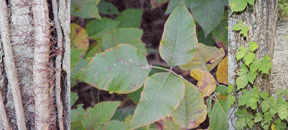
Volume XVII, Issue 30 # July 23 - July 29, 2009 |
 |
by Dr. Frank Gouin
How to Kill Poison Ivy
The Coasters tell you why
Measles make you bumpy
And mumps’ll make you lumpy
And chicken pox’ll make you jump and twitch
A common cold’ll fool you
And whooping cough’ll cool you
But poison ivy, Lord’ll make you itch!!
–The Coasters
Poison ivy is a very difficult weed to kill. Every year it produces an abundance of seeds that may remain dormant in the ground for years and still be capable of germinating. The leaves of poison ivy are covered with oil that tends to repel liquids; thus trying to kill the plant with a spray chemical is very difficult. Just as tricky is killing climbing ivy without injuring the desirable trees underneath.
Killing poison ivy vines climbing tree trunks is easy compared to the other methods. You need only a hatchet or machete and an oil can containing a 1:1 blend of Weed-B-Gone (Tri-Mec) and water. This method can be used only from July through November. Cut a notch half-way through the stem of the poison ivy vine and liberally apply the 1:1 blend on the lower cut surface of the wound. Take care not to spill the weed killer on the desirable tree trunk. The weed killer will be absorbed by the cells of the vine and kill the roots as well as sprouts from the roots. This method is called trunk injection.

![]() Killing poison ivy by spraying the foliage requires adding ammonium sulfate to the recommended amounts of Roundup. Adding a teaspoon of ammonium sulfate to a gallon of Roundup spray will dissolve the oils protecting the leaves of poison ivy, thus allowing the Roundup (glyphosate) to enter the leaf tissues and be translocated to the roots. Ammonium sulfate, a fertilizer containing approximately 13 percent nitrogen, is available from most garden centers or agricultural supply dealers. The most effective time of year to apply Roundup with ammonium sulfate to poison ivy leaves is from mid-June to early August.
Killing poison ivy by spraying the foliage requires adding ammonium sulfate to the recommended amounts of Roundup. Adding a teaspoon of ammonium sulfate to a gallon of Roundup spray will dissolve the oils protecting the leaves of poison ivy, thus allowing the Roundup (glyphosate) to enter the leaf tissues and be translocated to the roots. Ammonium sulfate, a fertilizer containing approximately 13 percent nitrogen, is available from most garden centers or agricultural supply dealers. The most effective time of year to apply Roundup with ammonium sulfate to poison ivy leaves is from mid-June to early August.
Selectively killing poison ivy growing among desirable plants can be done only with a wick applicator. A wick applicator looks like a hockey stick with a sponge-like material at the bottom and a bottle containing Roundup and ammonium sulfate at the top. When using this method, mix one part Roundup with seven parts water and add one teaspoon of ammonium sulfate per quart of solution. Wipe the wick carefully over the foliage of the poison ivy, taking care not to touch the foliage of the desirable plants. It is not necessary to wipe the entire surface of each leaf. A wick applicator can be made using a sponge paint roller at the end of a stick and moistening the roller in a wide-mouth jar of the Roundup ammonium sulfate solution. This method is effective only when applied from mid-June to early August.